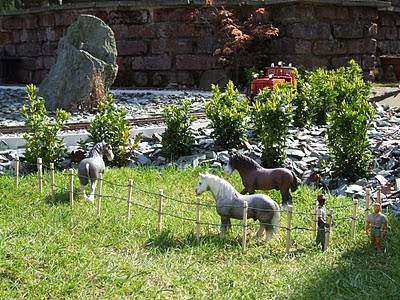Back in Spring 2009, the creation of Homestyal Light Railway began. Here follows the method that I used for the construction of the trackbed.
Most of my garden is relatively level so building the track bed wasn't too difficult as it only had to vary between two to four inches above the existing terrain.
Using LGB R3 (16000) curves and straight sections as templates I was able to construct the trackbed with tanalised decking planks supported on light weight breeze blocks positioned at regular intervals.
Most sections of curve were represented by two R3 (16000) pieces whereas each straight section was made from various lengths, all divisible by 300mm (10000).
Once the decking planks were in position each individual section was covered in heavy grade mineral roofing felt. This would both protect the wood from the elements and provide an initial surface for the track to adhere to prior to the ballast being laid.
Mineral felt laid, daffodils re-located and completion of the home loop.
The track bed was fitted with a 95mm x 6mm uPVC edging strip which would provide additional protection to the wood, allow future cabling to be routed and form a boundary for the 20mm green slate chippings. The strip sits approx 8mm above the felt (same height as the sleepers), which will allow for ballast (grit) to be laid in between and around the sleepers whilst preventing the ballast from spreading.
Before the chippings were put down a weed barrier membrane was laid to prevent weeds from re-appearing. The slate depth varies between 50mm and 80mm. In the foreground are small Boxus plants which in time will form a dwarf hedge.
With the laying of the chippings complete - the home loop awaits the introduction of ornamental grasses and monoliths and of course, HOMEstyal Halt Station.
Ornamental grasses, monoliths and a temporary location for HOMEstyal Halt Station complete the construction of the home loop.


















































